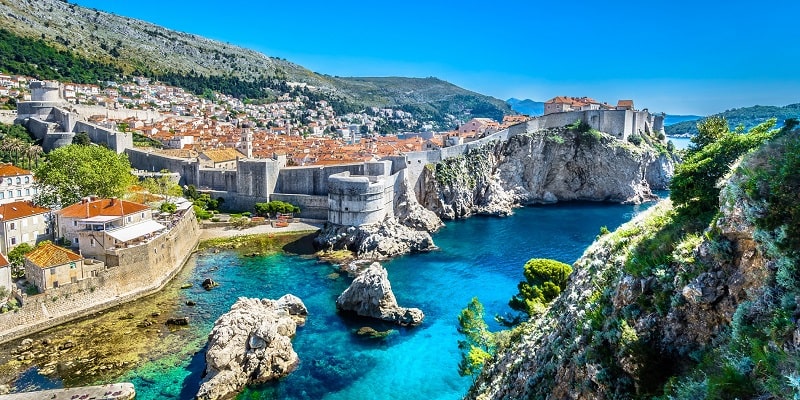
Cultural sights
28.12.2022.
The first impresion when someone mentions Croatia is a vacation, blue Adriatic sea and beaches, however, Croatia has many historical and cultural sights recognized outside its borders. One of the most famous international cultural and natural heritage lists is the UNESCO World Heritage List. By placing a cultural or natural sight on the world heritage list, UNESCO helps to preserve the natural and cultural heritage of a country or region, it helps to increase knowledge and promotes awareness of sights as well as it provides necessary help and initiates cooperation among members.
The cultural and natural heritage of Croatia listed on the UNESCO World Heritage List is: Plitvice Lakes National Park, Euphrasian Basilica in Poreč, Diocletian's Palace and Medieval Split, Old City of Dubrovnik, Historic City of Trogir, Stari Grad Plain on island of Hvar, the cathedral of St. James in Šibenik, stećci -medieval tombstones, Venetian works of defense between 16th and 17th centuries, and ancient and primeval beech forests of the Carpathians and other regions of Europe.
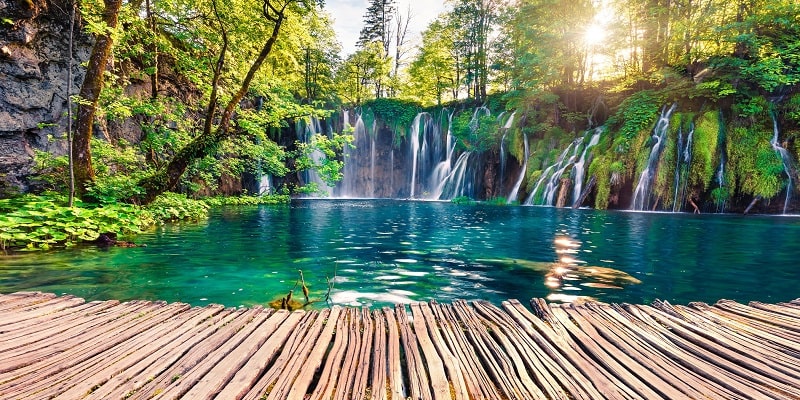
Plitvice Lakes is the most famous and most visited national park in Croatia, which was declared a national park in 1949. Plitvice Lakes is located near Korenica, in the center of Lika, and it consists of 16 connected lakes surrounded by steep cliffs and dense forests, which are inhabited by bears and wolves. One of the uniqueness of the Plitvice Lakes is the phenomenon of "sedge", whereby calcium carbonate deposits are constantly being constructed and formed. Plitvice Lakes National Park's highest waterfall is 70 meters high, after which the flow of Korana River begins. Plitvice Lakes National Park is one of the two Croatian natural sights listed on the UNESCO World Heritage List and it was included in 1979.
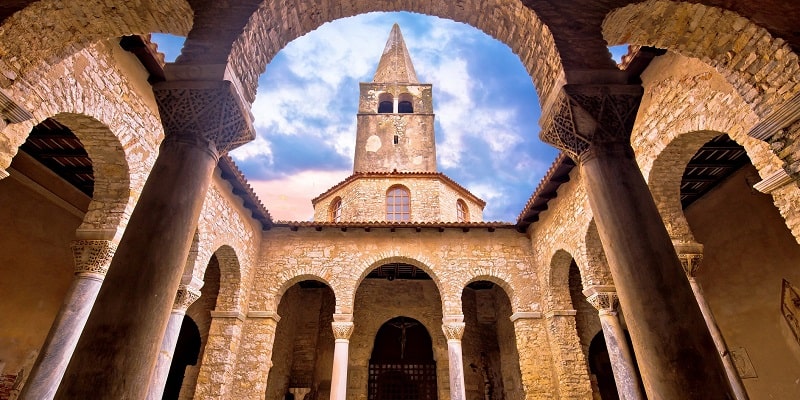
Euphrasian Basilica was named after the Bishop Euphrasius I, who began renovating the cathedral around 553 AD. The beautiful mosaics of the Virgin Mary on the throne, the martyrs and Christ have been preserved until today. Because of this, many consider Euphrasian Basilica as one of the most beautiful and preserved monuments of Byzantine culture and art in Eastern Europe. Historians believe that there were at least two early Christian churches on the place where Euphrasian basilica was built in the 6th century. Apart from the basilica, the Euphrasian Basilica complex includes the Mauro Orion, Sacristy, the Baptistery, the Parish Church, the Bishop's Palace and the Bell Tower. Over the years, Euphrasian Basilica experienced several changes and today's Gothic style was largely formed between the 13th and 15th centuries, while the bell tower was built in the 16th century.

Diocletian's Palace was built between the end of the 3rd century and the beginning of the 4th century during the reign of Emperor Diocletian. After his retirement, the Roman Emperor Diocletian stayed in Diocletian's palace until his death (316). Diocletian's Palace is one of the best preserved Byzantine monuments in Eastern Europe and it was built around 5 kilometers from Solin (at that time it was named Salon), which was the center of the Roman province of Dalmatia. Diocletian's Palace was built as a combination of a luxurious mansion on the south side and a military camp ("castrum") for Roman soldiers on the north, and it has dimensions of 180 x 215 meters. Inside Diocletian's palace, there is Diocletian's mausoleum which was later (around the 5th century) converted into a Christian church. In addition inside you can find Romanesque churches (from the 12th and 13th centuries), Gothic, Baroque and Romanesque palaces and medieval small fortresses.
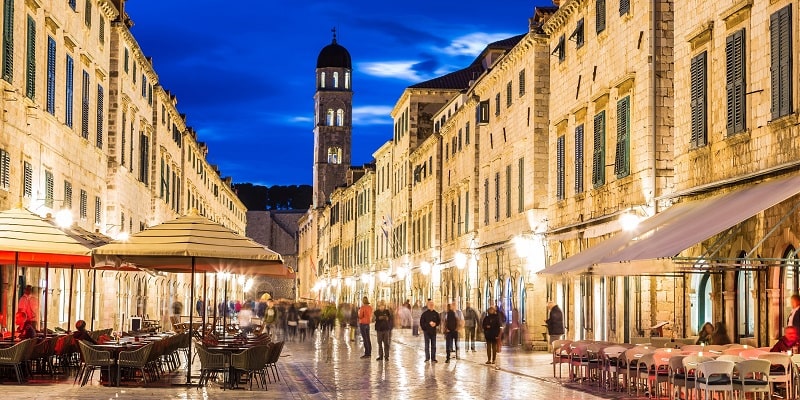
In the 13th century, the city of Dubrovnik become a naval force, and it based its development on diplomacy and maritime trade. As the capital of the Dubrovnik Republic, Dubrovnik was on the top during the 15th and 16th centuries, and its rich history and culture can still be seen today. The Old City of Dubrovnik represents the well-known 2 kilometers long City walls of Dubrovnik that surround the historic center. City walls of Dubrovnik and the historic center of Dubrovnik are one of the best preserved historical monuments in the Mediterranean. These are just some of the reasons why Dubrovnik has for years been one of the most visited cities in Croatia. Apart from the city walls, Dubrovnik's Old City is full of Renaissance, Gothic and Baroque churches, palaces, museums, monasteries and fountains and it is a home of Stradun - the main street of Dubrovnik.

The city of Trogir has a very long urban tradition since it has become a city 23 centuries ago. Over the centuries, Trogir has been influenced by Greek, Roman and Venetian styles whose characteristics are still visible today. This gorgeous Romanesque-Gothic city is one of the most beautiful city-museums that came to the World Cultural Heritage List. The city of Trogir has numerous architectural and cultural monuments - from the beautiful historic center of Trogir to the cathedral of St. Lovre built in the 12th century, the city museum, monasteries, churches, and the unique portal of Radovan. The old city street plan dates from the Hellenistic period, while the Romanesque churches are decorated with Baroque and Renaissance details, making the historic center of Trogir unique in the world.
The Stari Grad Plain on the island of Hvar has entered the UNESCO World Heritage List in 2008. What makes the Stari Grad Plain unique is a preservation of a cultural landscape which has remained almost unchanged since the 4th century BC, when the Ionic Greeks from Paros settled this area. On fertile soil of Stari Grad Plain, mainly olives and vineyards were grown, and this tradition has remained unchanged until today. In this area, there are many small stone buildings and ancient drywalls which confirm that the ancient Greeks used the geometric division of land. Those stone buildings have remained preserved even after 24 centuries.
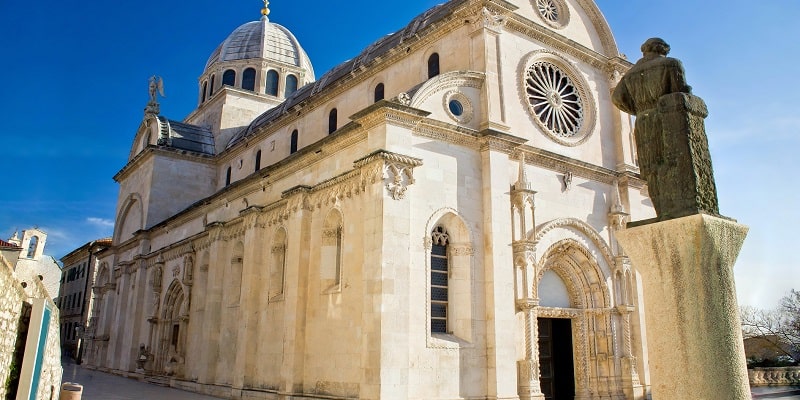
The Cathedral of St. James ("katedrala Sv. Jakova") in Šibenik is one of the most important architectural and historical monuments of this part of Europe, so it is no surprise that UNESCO included the cathedral to the World Cultural Heritage List. The Cathedral of St. James was builiding for more than a hundred years - according to preserved records, construction began in 1431 and it was completed in 1535. The cathedral was designed and constructed by three different architects in three different styles - architects were Francesco di Giacomo, Nikola Firentinac and Juraj Dalmatinac. What makes the cathedral unique is that only stone was used in construction. The cathedral of St. James is full of beautiful details, statues, sculptures, ornamented vaults which are the best examples of a successful mixture of Gothic and Renaissance art. Hence, the Cathedral has been the jewel of Šibenik and the entire region for centuries.
Stećci are limestone tombstones constructed in the Middle Ages - from the 12th to the 16th century. Stećci contained various ornaments and inscriptions which convey the tradition of the local people and community. There are more than 4000 of stećci, located in 28 different locations in Bosnia and Herzegovina (20 locations), Montenegro (3 locations), Serbia (3 locations) and Croatia (2 location). Stečci are evidence of the historical, artistic and spiritual wealth of the local population. In Croatia, stećci are located in Cista Provo near Imotski and in Konavle on Varina hill near the small church of St. Barbara.
The Venetian works of defense, listed on the UNESCO World Heritage List, can be found in three countries - Italy, Montenegro and Croatia. The cities or fortresses of the Venetian works of defense between the 16th and 17th centuries are characterized by unique organization, military architecture ("alla moderna model"), and shape with the main purpose of defense of the naval ports in the Mediterranean Sea and important trade routes. Venetian works of defense consist of 6 components stretching approximately 1000 kilometers - from Lombardy in Italy to the east of Adriatic Sea. Preserved Venetian works of defense in Croatia are the fortress of St. Nikola in Šibenik and the defense system in Zadar. Other preserved Venetian works of defense are located in Italy (Fortress Palmanova, Peschiera del Garda and Bergamo) and in Montenegro (the town of Kotor).
The ancient and primeval beech forests of the Carpathians and other regions of Europe stretch across 12 different countries. The European beech is adaptable to different geographic and climate conditions, and therefore, after the end of the last ice age, it began to spread across the Carpathians, the Alps, the Pyrenees, the Mediterranean, and the Dinarides. Apart from Croatia, the beech forest spread to Ukraine, Germany, Belgium, Albania, Austria, Italy, Bulgaria, Romania, Slovenia, Slovakia, and Spain. The beech forests have continued to spread until today. The Beech Forest in Croatia is located in two locations in the Northern Velebit National Park, with a total size of nearly 1290 hectares and in the Paklenica National Park, with a total size of nearly 2030 hectares.
In addition to the UNESCO World Heritage List, there is also the Tentative list of cultural and natural sights of Croatia which have been nominated to the main list. This tentative list includes: Hermitage Blaca on the island of Brač, Zadar - Episcopal complex, the historic town of Korčula, Kornati National Park and Telašćica Nature Park, the Croatian limes near the Danube, the Primošten vineyards, the city of Motovun, Velebit mountain, Lubenice on the island of Cres, Historic nucleus and Old Town in Varaždin, Osijek's Fortress Tvrda, the extension of Diocletian's palace and the historical nucleus of Split, the historical town planning ensemble of Ston with Mali Ston, Burg - castle of Veliki Tabor, and Lonjsko Polje Nature Park.
UNESCO cultural sights historical sights natural sights world heritage
Our recommendation
Where to go, stay and what to do?
